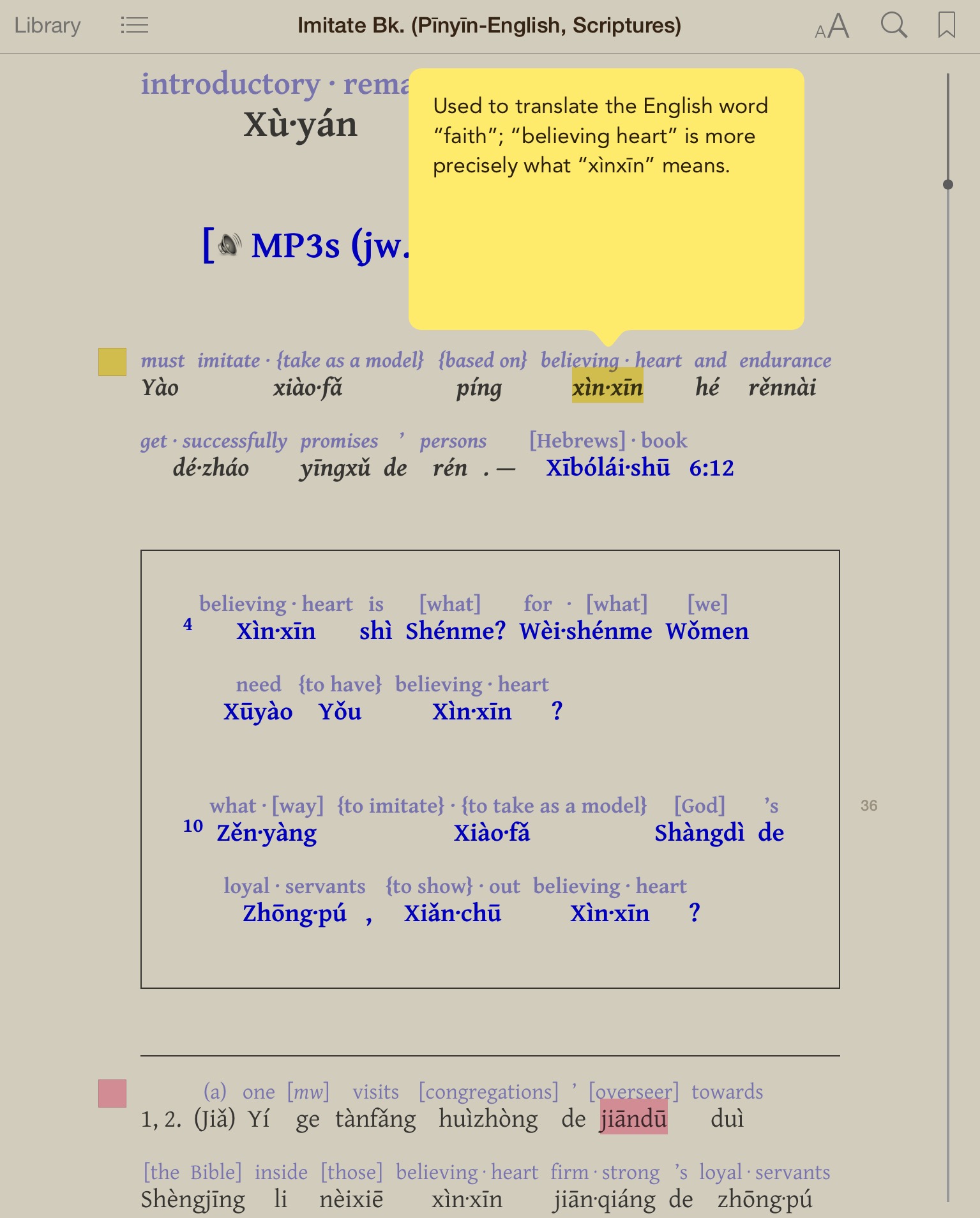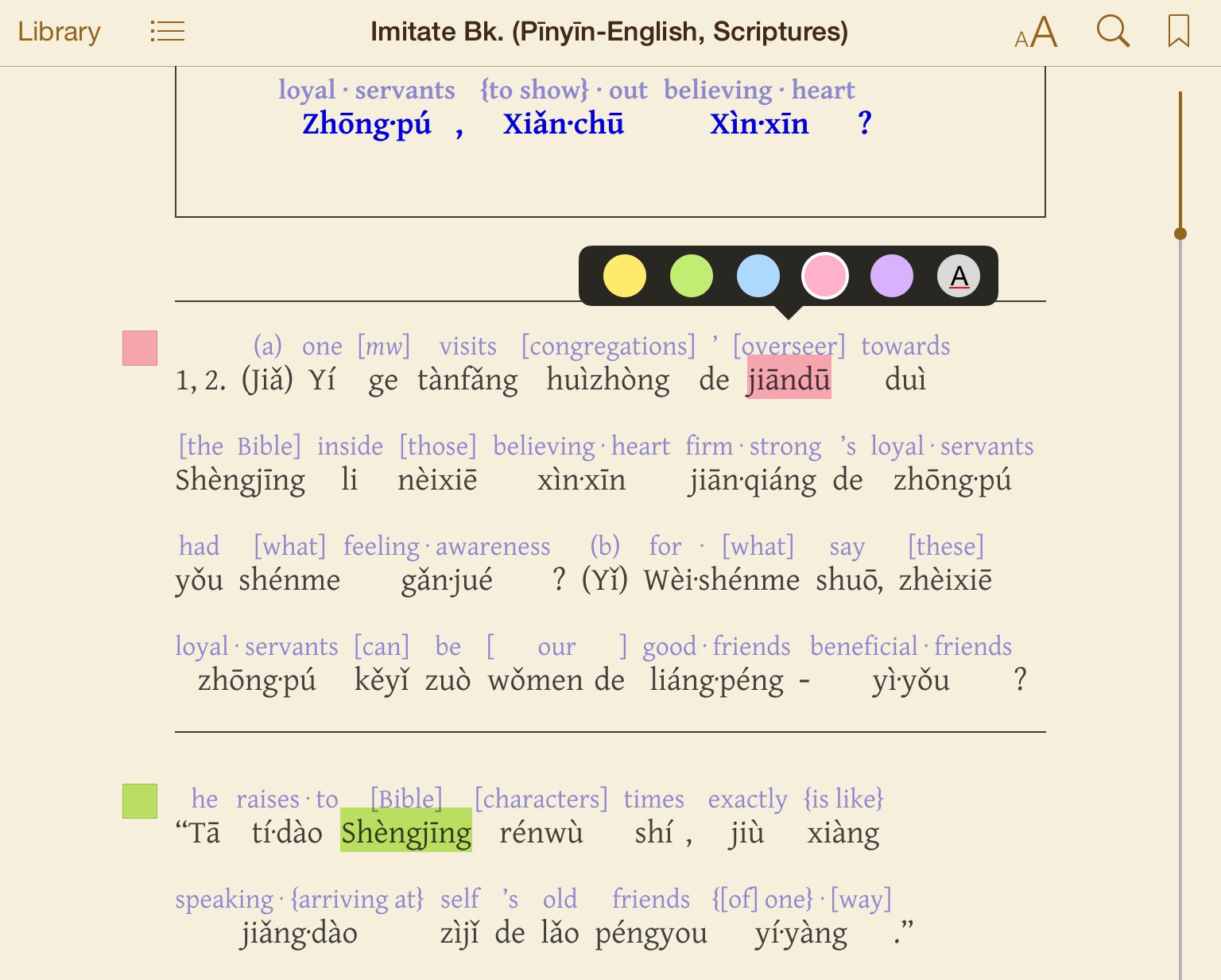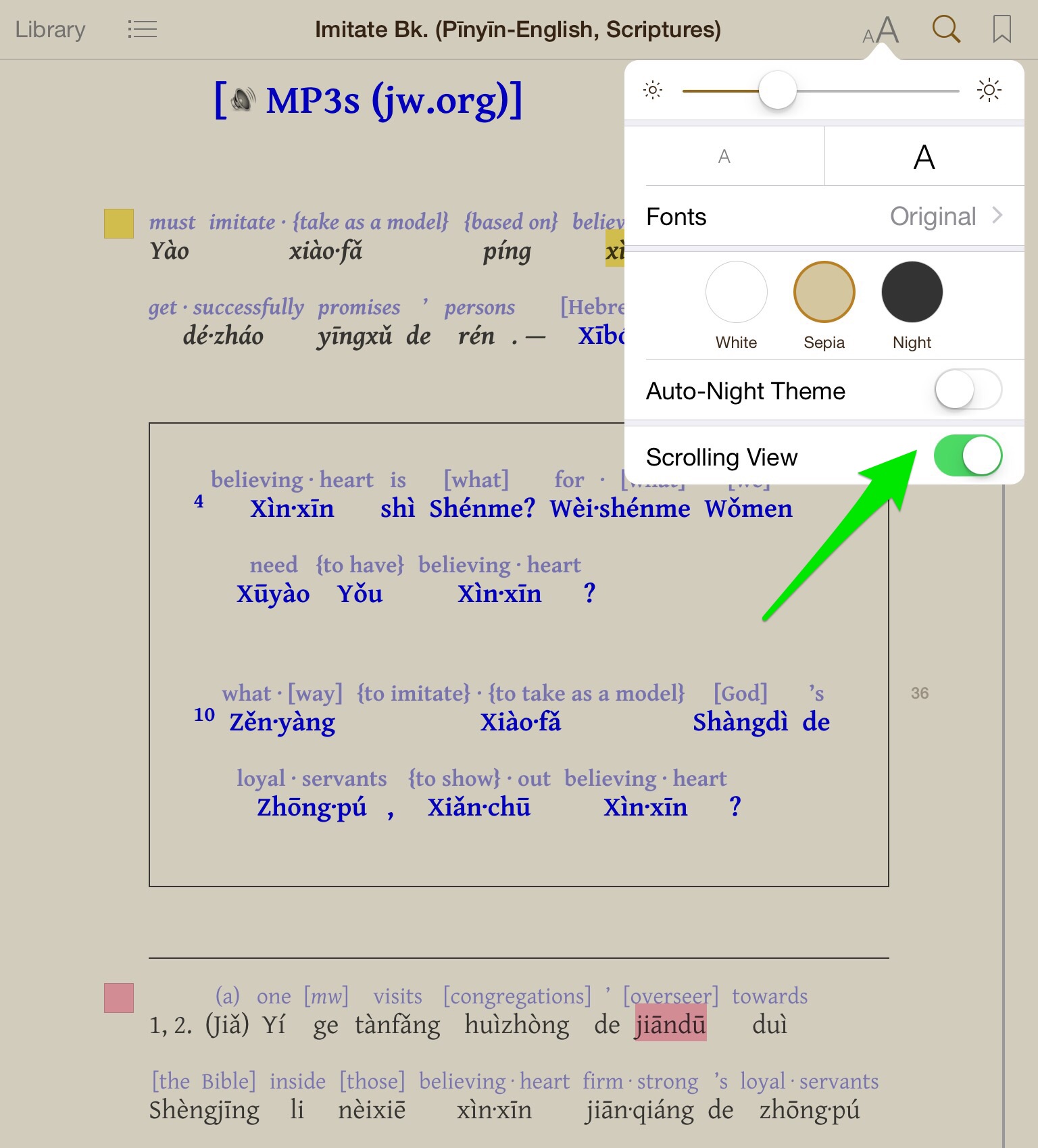 Imitate Bk.
Imitate Bk.
(Pīnyīn-English, Scriptures, EPUB)
Updated 2018-08-03
Short Links:
Links ▶ Publications ▶ Books ▶
Imitate Book Links (tiandi.info/ia)
Contents
Introduction
The material in the EPUB file linked to by the download link below contains text from the Chinese Imitate book, written in Pīnyīn. It also includes English ruby text that has been bundled with the Pīnyīn text that it shows the meaning of. Thus, while making better use of limited display real estate on mobile devices compared to corresponding 3-line material, this material provides us Mandarin-learners with assistance in the two language aspects we require in order to be able to discuss or study the Imitate book with someone in Mandarin:
- The pronunciations of the Mandarin words used
- These show us how to communicate the Imitate book’s message in Mandarin.
- The meanings of the Mandarin words used
- These show us what is being communicated in Mandarin.
Chinese characters may be the traditional writing system for Mandarin, but they incur very high costs in terms of the ongoing time, attention, and effort required to learn and remember them. However, our focus should really be on understanding Mandarin speech and speaking Mandarin understandably. (1 Corinthians 14:8–11) Pīnyīn is a simple full writing system for Mandarin that can help us to focus on and successfully develop these primarily required abilities. (There is more information on this below.)

 Advantages of the EPUB Format (tap/click to show) (tap/click to hide)
Advantages of the EPUB Format (tap/click to show) (tap/click to hide)


EPUB annotation in iBooks
Being in EPUB format allows this material to benefit from the advantages of this format, including:
- Broad hardware and software support
- Easy enlarging and automatic reflowing of the text to accommodate displays of various shapes and sizes, including those of many mobile devices
- This is especially an advantage compared to the situation with PDF files, which have preset page sizes and line endings baked in. As a result, PDF files are often cumbersome and difficult to read on smaller mobile devices.
- Offline use
- Since EPUB files have been available from jw.org for a long time, many publishers in the Mandarin field are now familiar with how to download EPUB files and use them offline.
- Annotation (notes, highlighting, etc.) support
- EPUB files can be easily annotated by users in apps such as iBooks, which runs on the iPad, the iPhone, the iPod touch, and Mac computers. There are also apps that annotate EPUB files on Windows, Android, etc.
- Hyperlinking that is familiar and expected, and that thus will get used and benefited from
- Taking advantage of this, scripture references in the main text are links to the full text of the cited scriptures. There, links are provided for returning to the referring citations in the main text.
- Links are also provided for “teleporting” from the table of contents to the chapter headings and back. After each chapter heading, links are provided for “teleporting” to the chapter’s subheadings and back.
- As well, links are provided as necessary for going to any footnotes, etc., and for returning from them to the main text.
- Producibility and editability with simpler, more accessible, more mobile tools
- Whereas at this time Microsoft Word running on a desktop or laptop PC is needed to produce satisfactory 3-line PDF files, this plain text-based Pīnyīn-English EPUB material can be satisfactorily partly produced and edited with even an app running on a mobile device like an iPad.

 Pīnyīn is a Good, Workable Writing System On Its Own (tap/click to show) (tap/click to hide)
Pīnyīn is a Good, Workable Writing System On Its Own (tap/click to show) (tap/click to hide)
Reading just Pīnyīn may take some getting used to if you’re accustomed to reading (or trying to read) Hànzì (Chinese characters), but going by first principles of linguistics (the scientific study of language) rather than mere human traditions, it should be more than worth the effort. You should at least give yourself a chance to get used to it.
“One of the basic assumptions of modern linguistics [the scientific study of language]…is that speech is primary and writing is secondary”. Yes, speech is the foundation on which writing must be built, not vice versa. (That is just a natural result of the way Jehovah made us—he gave our bodies the built-in ability to produce speech, but writing requires external aids such as pens and paper, keyboards and screens, etc.) Thus, it is very good that Pīnyīn represents Mandarin speech so straightforwardly and easily, and that it enables us to focus on speech. Yes, while Chinese characters, as beautiful and traditional as they are, demand distractingly large commitments of precious time and energy just for themselves, Pīnyīn frees and empowers us to focus on communicating the good news.
Indeed, in our ministry specifically, we definitely need to understand speech and to speak understandably much more than we need to read and write. (1 Corinthians 14:8–11) So, while many who have received traditional Mandarin language instruction have been influenced to believe that being able to read and write characters is the ultimate goal for a Mandarin language student to aspire to, actually, for us Kingdom publishers, our ultimate goal regarding Mandarin should be being able to understand and speak spoken Mandarin, so that we can preach and teach the good news effectively, from our hearts, using Mandarin speech. So, really, for us Kingdom publishers, being able to read, understand, and write Pīnyīn, which directly represents Mandarin speech, is a more relevant and important (and easy-to-achieve) goal to aspire to than being able to read, understand, and write characters, which unfortunately have become this thing on their own that has warped and obfuscated Mandarin speech rather than supporting it.
But, is Pīnyīn even really a writing system? Interestingly, the Chinese national standard Zhōngguó Mángwén (中国盲文/中國盲文, Chinese Braille) is basically a transliteration or conversion of Pīnyīn into braille letters. Braille is obviously a writing system, so Pīnyīn must also be a writing system, not just a pronunciation aid.
Also, as a Sumerian proverb stated, “a scribe whose hand matches the mouth, he is indeed a scribe”. Pīnyīn can indeed be used to write anything that can be spoken in Modern Standard Mandarin, from the simplest expressions to the most advanced, complex, and deeply meaningful expressions, so it qualifies as a full writing system in that fundamental sense as well.
Really, after a bit of research into what the definition of a “writing system” is, it becomes evident that a system like Pīnyīn should naturally be considered a writing system, in spite of the efforts of worldly Chinese intellectuals to artificially and unjustly keep Pīnyīn down in order to protect and enshrine the traditional Hànzì writing system that they have so much invested in.
Since Pīnyīn is not just a pronunciation aid, but a full writing system, it is not “training wheels”—it’s regular wheels. On the other hand, Chinese characters are like non-round wheels—more difficult than necessary. While some may find non-round wheels “interesting”, or maybe even “beautiful”, much of the time we just need to get from point A to point B as quickly and easily as possible. We may even need to do so to save someone’s life. For example, what kind of wheels should be on an ambulance? That’s the kind of “wheels” we should be using in our life-saving work.
That Pīnyīn is a full writing system for any and all Modern Standard Mandarin speech also means that, in addition to it being correct to say that “Pīnyīn is Chinese” because it was developed in China by Chinese people, it is also quite correct to say that “Pīnyīn is Chinese” in the sense that, even if it isn’t Hànzì, it is indeed written Mandarin Chinese—it’s not as if Pīnyīn were written English or French or something!
But, aren’t characters more meaningful than Pīnyīn? There are certainly meanings and stories behind how certain characters are written, but taken as a bewitchingly complex, independent system for directly representing meanings visually, the characters can actually be a distraction or a diversion from the Mandarin words themselves, which are already a system of representing meanings through Mandarin speech sounds. Really, a Mandarin word still means what it means, no more and no less, whether it is spoken, written in characters, or written in Pīnyīn. Shakespeare said that “a rose by any other name would smell as sweet”, and indeed, a rose would smell as sweet whether the spoken Mandarin word for it is written as “玫瑰” or as “méigui”. Writing the word in characters does not add to its meaning, and writing it in Pīnyīn does not take away from its meaning.
Practically speaking, we should keep in mind that, as many in the Mandarin field have found, by investing the minimal amount of time and effort needed to learn and get used to the Pīnyīn system, we will be equipped to always be able to quickly and easily read anything in Mandarin that’s written in Pīnyīn, and we will always be able to quickly and easily write anything in Mandarin using Pīnyīn. In contrast, even those who are fairly familiar with Chinese characters will at times come across unfamiliar or forgotten characters whose meanings and pronunciations they can only guess at. Also, even those who are fairly familiar with Chinese characters will at times be completely unable to remember or figure out how to write a certain character.
But, does using Pīnyīn mean that we are failing to show proper respect for Chinese culture? Since, as mentioned above, the Pīnyīn system was developed in China by Chinese people, it is a product of Chinese culture, and it is a part of Chinese culture. So, using Pīnyīn is not an imposition of Western culture—it is an application of Chinese culture! While Pīnyīn uses the Latin alphabet, it does so because the Chinese developers of Pīnyīn of their own free will purposely chose to base it on this international alphabet (it’s not just the English alphabet) so that users of Pīnyīn would benefit from its familiarity. This Chinese design decision has caused the international Latin alphabet to be adopted as part of Chinese culture. As Zhōu Ēnlái (the first Premier of the People’s Republic of China) said, ‘When we adopt the Latin alphabet, in which we make necessary adjustments to suit the needs of the Chinese language, it becomes the phonetic alphabet of our language and is no longer the alphabet of ancient Latin, still less the alphabet of any foreign country.’
While those who love traditional Chinese culture may dislike such a radical innovation, it can be said that such innovations are actually a sign of positive, healthy cultural development. Another example of such a radical but positive innovation was the West and China moving from always using Roman numerals and the Chinese characters for numbers to mostly using Arabic numerals. I’m sure most would agree that it’s a very good thing that we no longer have to deal with CMXXXVI÷III or 九百三十六÷三, because we can just work out 936÷3! Pīnyīn brings similar benefits as a writing system for Mandarin.
Anyway, the merely human cultures and traditions of this world that is passing away should not be the most important things to us Witnesses of Jehovah. (Mark 7:13; 1 John 2:17) The most important thing for us to consider is the truth about what really works best for our God-given work of sanctifying Jehovah’s name, preaching the good news of the Kingdom, and helping to save the lives of those who respond positively to that good news.—John 4:24; Matthew 6:9; 24:14; 1 Timothy 2:3, 4.
The truth is that, based on first principles of language science that help us to understand how Jehovah actually designed us humans to learn and use language, Pīnyīn is a good, workable writing system on its own for Modern Standard Mandarin. Not only that, but the experiences of many in the Mandarin field also provide living proof that Pīnyīn works much more quickly, easily, and effectively than Chinese characters do for helping publishers who are learning Mandarin to become effective preachers and teachers in the Mandarin field.
For a more in-depth discussion about how we in the Chinese field should view Pīnyīn, see the article “Pīnyīn Was Plan A”. Here is a quote from it:
“That there are so many different words in modern Mandarin that sound the same is not a good reason not to use Pīnyīn, any more than it is a good reason not to speak Mandarin.”

 Translation (tap/click to show) (tap/click to hide)
Translation (tap/click to show) (tap/click to hide)
The English translation follows these principles:
- As far as is practical, the meaning of each individual Mandarin morpheme (smallest unit of language sound with meaning) is translated literally according to how it is used in the context in which it appears. (In Mandarin, morphemes usually correspond with syllables, but some syllables are sound-only and thus not morphemes, and some morphemes have more than one syllable.)
- Interpuncts (·) are used to separate sections of meaning.
- E.g., in
lái·zì
,
- “lái” corresponds with “ ”, and
- “zì” corresponds with “ ”.
- E.g., in
lái·zì
,
- If a set of English words is surrounded by curly brackets, or braces, i.e. { }, then that set of English words conveys the literal meaning of the Mandarin morpheme(s) it corresponds to.
- When a single English word or a set of English words surrounded by curly brackets corresponds to two or more Mandarin morphemes, that means that it conveys the literal meaning of each of those Mandarin morphemes.
- E.g., in bāngzhù , “ ” is the literal meaning of both “bāng” and “zhù”.
- When literal translations do not make sense, or are not understandable enough, then the effective meanings are used instead, surrounded by square brackets, i.e. [ ].
- When literal translations may not be understandable enough on their own, but can still be useful to know, the literal translations may be shown, followed by their effective meanings.
- E.g., with yí·dìng , it can be seen that with “yí·dìng”, the literal translations “ ” lead to an effective meaning of “ ”.
- English words corresponding to Mandarin syllables that are selected for their sound and not their meaning, such as those used to represent non-Mandarin names, are not surrounded by square brackets. (In such cases, the sound of those Mandarin syllables practically is their meaning.) However, sets of such corresponding English words are surrounded by curly brackets.
This approach to translating can sometimes result in English translations that don’t follow traditional English usage patterns. However, the purpose of the material is not necessarily to move the hearts of English-speaking publishers through the use of their mother tongue. Rather, the purpose of the material is to help publishers to understand and speak Mandarin better, so that they can ultimately better move the hearts of Mandarin-speaking Bible students through the use of their mother tongue.

 Proofreading (tap/click to show) (tap/click to hide)
Proofreading (tap/click to show) (tap/click to hide)
The regular portions of this Imitate book material have been carefully translated, rendered, and proofread. Thus, those who are learning Mandarin can reliably use them to help increase their insight into the meanings of Mandarin expressions, as well as their insight into how these expressions are used in various contexts. Of course, the proofread portions of this material may still contain errors. If you find any, please email me to let me know.
Any unproofread or partially proofread material is rendered with a lower-contrast grey background. It may be fully proofread later as time allows.

 Downloading and Opening the File (tap/click to show) (tap/click to hide)
Downloading and Opening the File (tap/click to show) (tap/click to hide)
To download and open the file on an iPad, iPhone, or iPod touch:
- If iBooks is not already installed, go here to download and install it from the App Store.
- In Safari, tap on the download link below.
- Tap on the Open in “iBooks” button that appears after the EPUB file has finished downloading in Safari.
- Each updated EPUB file now has its update date in the filename and in the title. This has been found to be necessary to prevent Apple’s iCloud syncing from getting confused re the different versions of the file. If you wish, you may copy over any notes, etc., from the older versions to the latest version, and then delete the older versions.
For more information on setting up and using iBooks on an iPad, iPhone, or iPod touch, see Apple’s support page for that.
To download and open the file on a PC or a Mac:
- Right-click on the download link below and select Save Link As..., or Save Target As..., or Download Linked File As..., or something similar depending on your browser.
- Select a folder on your hard drive to save the file to and click the Save button or something similar to proceed with the download.
- There are many apps with which one can view and annotate EPUB files on Windows, Mac, and Linux personal computers. For example, Apple’s iBooks app is now included with OS X on the Mac.

 Using the File in iBooks (tap/click to show) (tap/click to hide)
Using the File in iBooks (tap/click to show) (tap/click to hide)
- On an iPad, iPhone, or iPod touch, iBooks must be running on iOS 6 or newer for it to be able to properly render the wordspacing. Any Mac version of iBooks should work fine in this respect.
- On an iPad, iPhone, or iPod touch, go to the Settings app, iBooks section, and turn off Full Justification.
- In iBooks, use the Sepia or White theme to allow the English ruby text be a different colour, and to allow the unproofread material to have a different background colour. (The Night theme changes all the text to be the same colour, and it sets the background colour to be black everywhere.)
- On an iPad, iPhone, or iPod touch, using Scrolling View works well, and it is a fast way of, yes, scrolling through the material. (These devices are rightly known for how quickly and smoothly they can scroll.)
- On smaller devices like the iPhone, using Scrolling View in landscape orientation is especially highly recommended.

Selecting Scrolling View in iBooks
For more information on setting up and using iBooks on an iPad, iPhone, or iPod touch, see Apple’s support page for that.

 Using the File on Android (tap/click to show) (tap/click to hide)
Using the File on Android (tap/click to show) (tap/click to hide)
In my testing so far, this app has worked well as a reader for the EPUB file linked to below:
In my testing so far, these apps have failed to properly render the EPUB file linked to below:
- Google Play Books
- Moon+ Reader
- Cool Reader

 Disclaimer (tap/click to show) (tap/click to hide)
Disclaimer (tap/click to show) (tap/click to hide)
This is not a publication of the Watchtower Bible and Tract Society, and if an Imitate book is available, this material should be used along with it, not instead of it. This material is only meant to help publishers working in the Mandarin field, so that they can more quickly become more effective at preaching and teaching the good news to Mandarin-speaking people without being unnecessarily obstructed and delayed by the complex and difficult-to-learn-and-remember Chinese characters.
IMPORTANT: Please do not use this material as an excuse or as a crutch to just “get by” or “muddle through” at Chinese meetings or Bible discussions. By all means, make good use of this material in such settings, but most importantly, use this material to help you really improve your knowledge and understanding of the Chinese language, so that you can 1) listen with more understanding and 2) speak more effectively from your heart while praising Jehovah and preaching and teaching the good news in the Chinese field.

 Updates and Other Information (tap/click to show) (tap/click to hide)
Updates and Other Information (tap/click to show) (tap/click to hide)
Check the Links News blog (news feed, Twitter) for news regarding updates to this resource, and also for news regarding other resources prepared by our fellow workers in the Chinese field. You may also find it interesting to check out the tiandi.info blog (news feed, Twitter), which is about various things related to the Chinese field. (If you need login information for the parts of tiandi.info that require it, request it by email, and include information on who referred you and/or what group/cong. you are in.)
To follow the Twitter account for the Links News and tiandi.info blogs, click or tap this button:
If you have any questions or comments, email me.
Enjoy using the material. May it help you to serve more effectively and joyfully in the Mandarin field.
Download Link
Imitate Book (Pīnyīn-English, Scriptures) EPUB 2016-09-16
(proofread, mobile-friendly,
context-appropriate English translations
with literal & effective meanings,
picture links, audio links, subheading links,
supports offline use & annotation)
Pīnyīn-English material:
Front Cover to Ch. 20, Par. 8;
Ch. 20, Par. 14 to 19,
and much of the rest of Ch. 20;
Ch. 21, Par. 1 to 17,
and much of the rest of Ch. 21;
Ch. 22, Par. 1 to 16,
and much of the rest of Ch. 22;
Ch. 23, Par. 1 to 5, 15 to 18,
and much of the rest of Ch. 23;
Conclusion, Par. 1 to 7,
and much of the rest of the Conclusion
(Material that has been partially proofread
is rendered with a lower-contrast grey background.)